What Is Inquiry-Based Learning:
VerifiedAdded on 2022/08/27
|12
|2959
|20
AI Summary
Contribute Materials
Your contribution can guide someone’s learning journey. Share your
documents today.
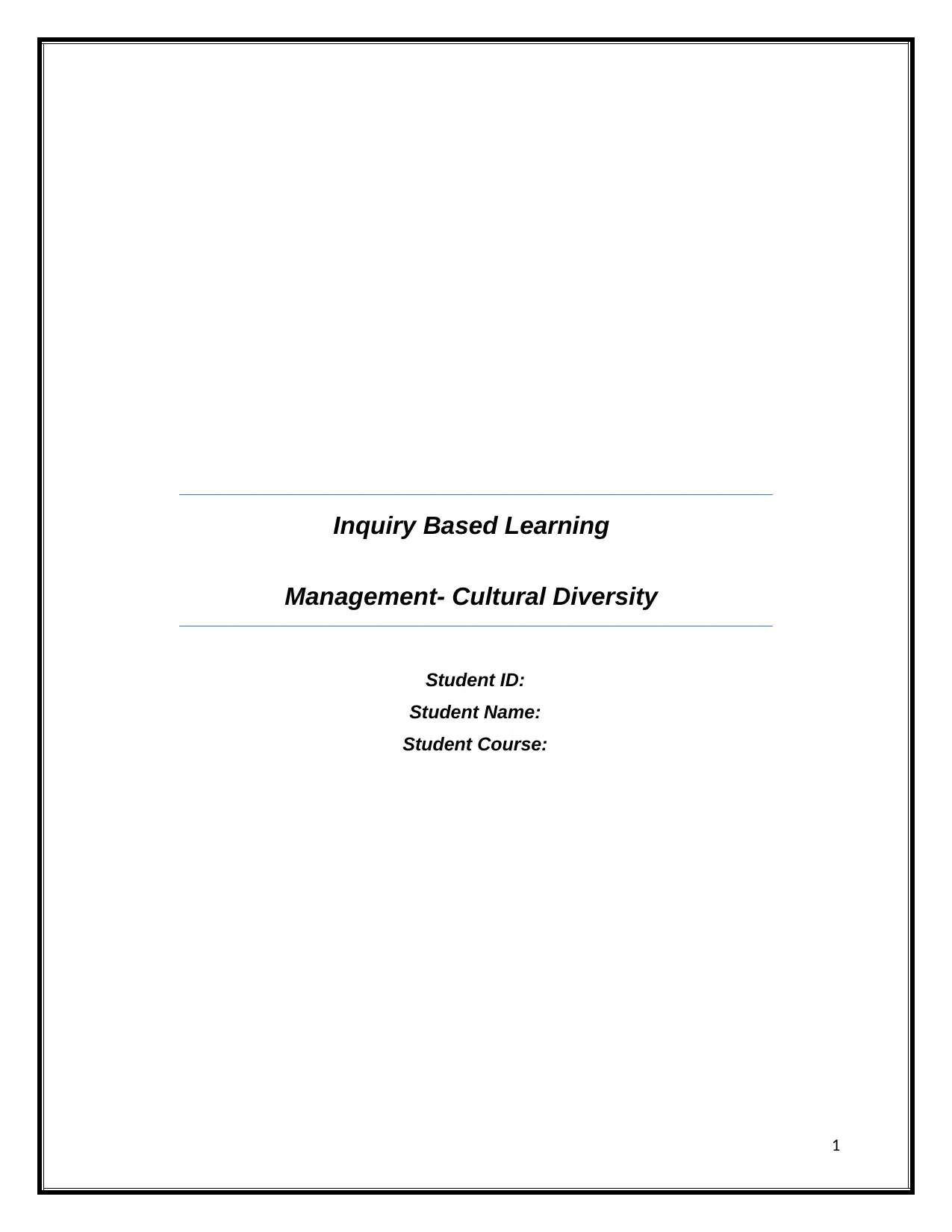
Inquiry Based Learning
Management- Cultural Diversity
Student ID:
Student Name:
Student Course:
1
Management- Cultural Diversity
Student ID:
Student Name:
Student Course:
1
Secure Best Marks with AI Grader
Need help grading? Try our AI Grader for instant feedback on your assignments.
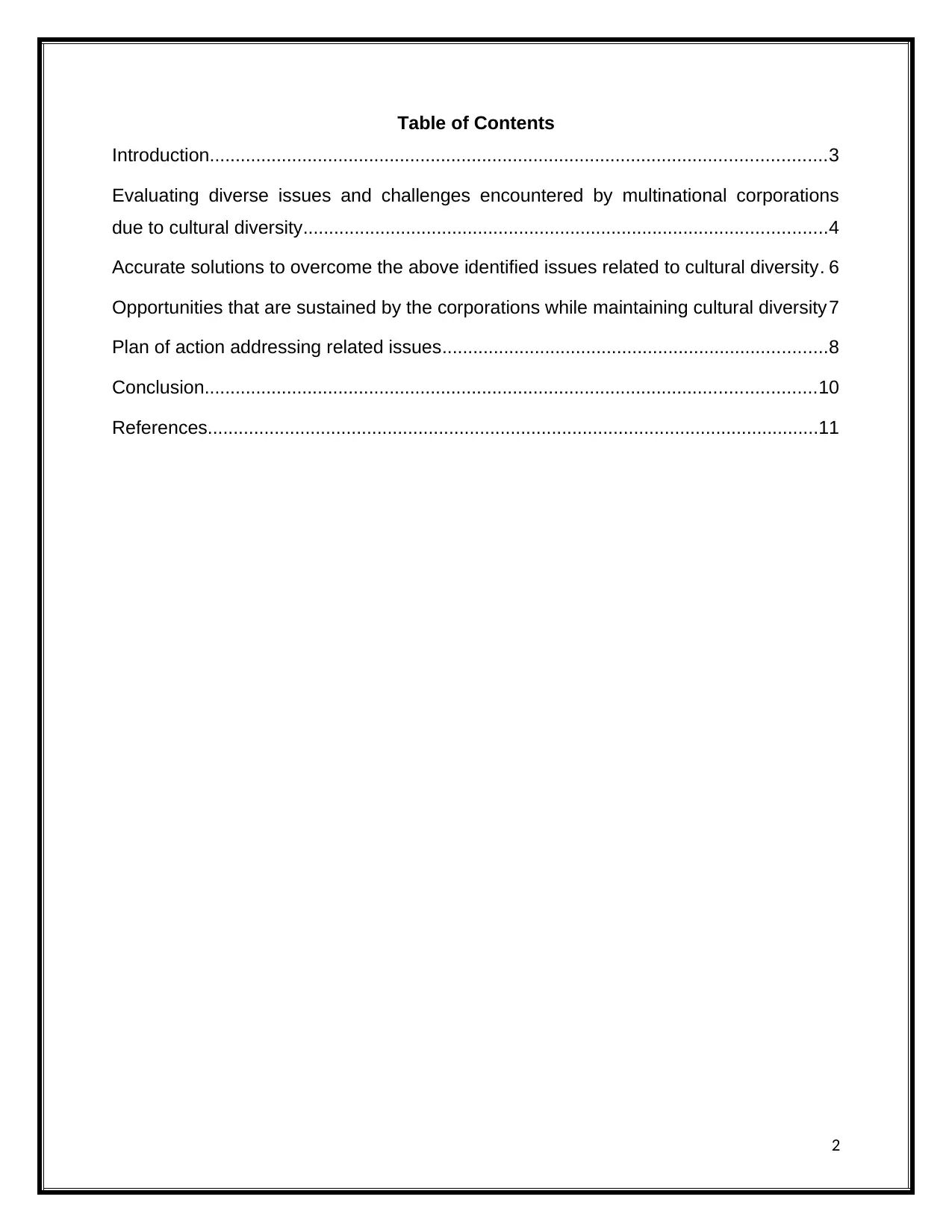
Table of Contents
Introduction........................................................................................................................3
Evaluating diverse issues and challenges encountered by multinational corporations
due to cultural diversity......................................................................................................4
Accurate solutions to overcome the above identified issues related to cultural diversity. 6
Opportunities that are sustained by the corporations while maintaining cultural diversity7
Plan of action addressing related issues...........................................................................8
Conclusion.......................................................................................................................10
References.......................................................................................................................11
2
Introduction........................................................................................................................3
Evaluating diverse issues and challenges encountered by multinational corporations
due to cultural diversity......................................................................................................4
Accurate solutions to overcome the above identified issues related to cultural diversity. 6
Opportunities that are sustained by the corporations while maintaining cultural diversity7
Plan of action addressing related issues...........................................................................8
Conclusion.......................................................................................................................10
References.......................................................................................................................11
2
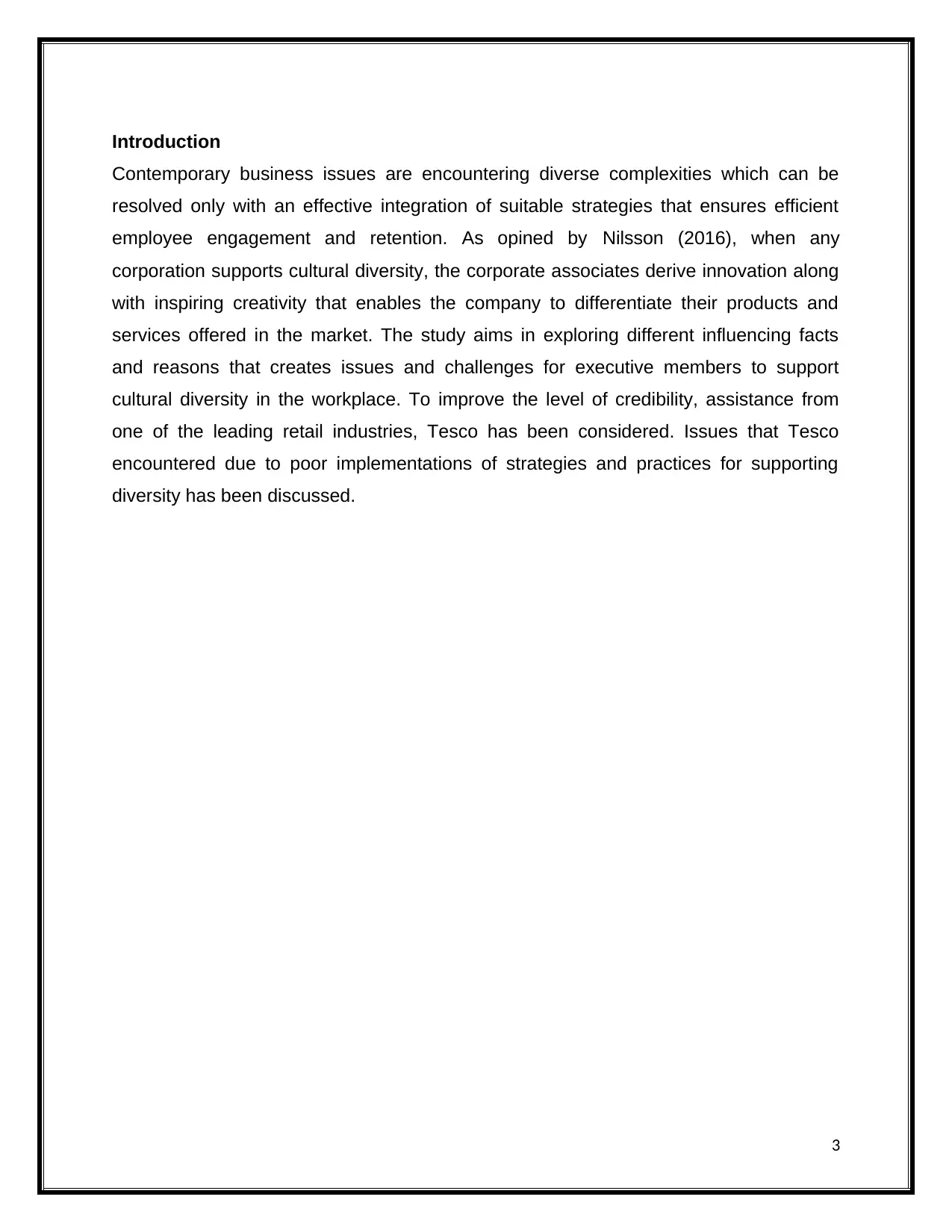
Introduction
Contemporary business issues are encountering diverse complexities which can be
resolved only with an effective integration of suitable strategies that ensures efficient
employee engagement and retention. As opined by Nilsson (2016), when any
corporation supports cultural diversity, the corporate associates derive innovation along
with inspiring creativity that enables the company to differentiate their products and
services offered in the market. The study aims in exploring different influencing facts
and reasons that creates issues and challenges for executive members to support
cultural diversity in the workplace. To improve the level of credibility, assistance from
one of the leading retail industries, Tesco has been considered. Issues that Tesco
encountered due to poor implementations of strategies and practices for supporting
diversity has been discussed.
3
Contemporary business issues are encountering diverse complexities which can be
resolved only with an effective integration of suitable strategies that ensures efficient
employee engagement and retention. As opined by Nilsson (2016), when any
corporation supports cultural diversity, the corporate associates derive innovation along
with inspiring creativity that enables the company to differentiate their products and
services offered in the market. The study aims in exploring different influencing facts
and reasons that creates issues and challenges for executive members to support
cultural diversity in the workplace. To improve the level of credibility, assistance from
one of the leading retail industries, Tesco has been considered. Issues that Tesco
encountered due to poor implementations of strategies and practices for supporting
diversity has been discussed.
3
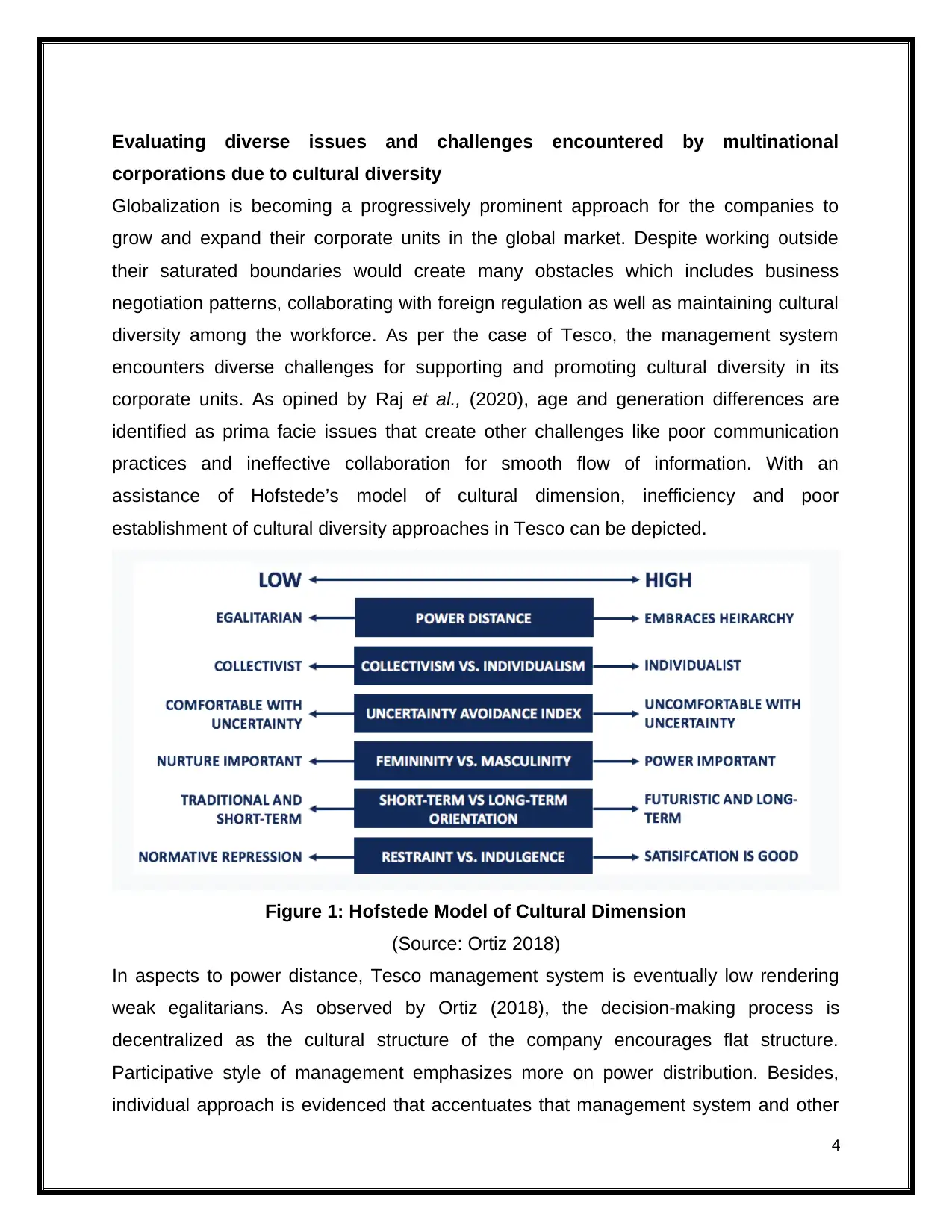
Evaluating diverse issues and challenges encountered by multinational
corporations due to cultural diversity
Globalization is becoming a progressively prominent approach for the companies to
grow and expand their corporate units in the global market. Despite working outside
their saturated boundaries would create many obstacles which includes business
negotiation patterns, collaborating with foreign regulation as well as maintaining cultural
diversity among the workforce. As per the case of Tesco, the management system
encounters diverse challenges for supporting and promoting cultural diversity in its
corporate units. As opined by Raj et al., (2020), age and generation differences are
identified as prima facie issues that create other challenges like poor communication
practices and ineffective collaboration for smooth flow of information. With an
assistance of Hofstede’s model of cultural dimension, inefficiency and poor
establishment of cultural diversity approaches in Tesco can be depicted.
Figure 1: Hofstede Model of Cultural Dimension
(Source: Ortiz 2018)
In aspects to power distance, Tesco management system is eventually low rendering
weak egalitarians. As observed by Ortiz (2018), the decision-making process is
decentralized as the cultural structure of the company encourages flat structure.
Participative style of management emphasizes more on power distribution. Besides,
individual approach is evidenced that accentuates that management system and other
4
corporations due to cultural diversity
Globalization is becoming a progressively prominent approach for the companies to
grow and expand their corporate units in the global market. Despite working outside
their saturated boundaries would create many obstacles which includes business
negotiation patterns, collaborating with foreign regulation as well as maintaining cultural
diversity among the workforce. As per the case of Tesco, the management system
encounters diverse challenges for supporting and promoting cultural diversity in its
corporate units. As opined by Raj et al., (2020), age and generation differences are
identified as prima facie issues that create other challenges like poor communication
practices and ineffective collaboration for smooth flow of information. With an
assistance of Hofstede’s model of cultural dimension, inefficiency and poor
establishment of cultural diversity approaches in Tesco can be depicted.
Figure 1: Hofstede Model of Cultural Dimension
(Source: Ortiz 2018)
In aspects to power distance, Tesco management system is eventually low rendering
weak egalitarians. As observed by Ortiz (2018), the decision-making process is
decentralized as the cultural structure of the company encourages flat structure.
Participative style of management emphasizes more on power distribution. Besides,
individual approach is evidenced that accentuates that management system and other
4
Secure Best Marks with AI Grader
Need help grading? Try our AI Grader for instant feedback on your assignments.
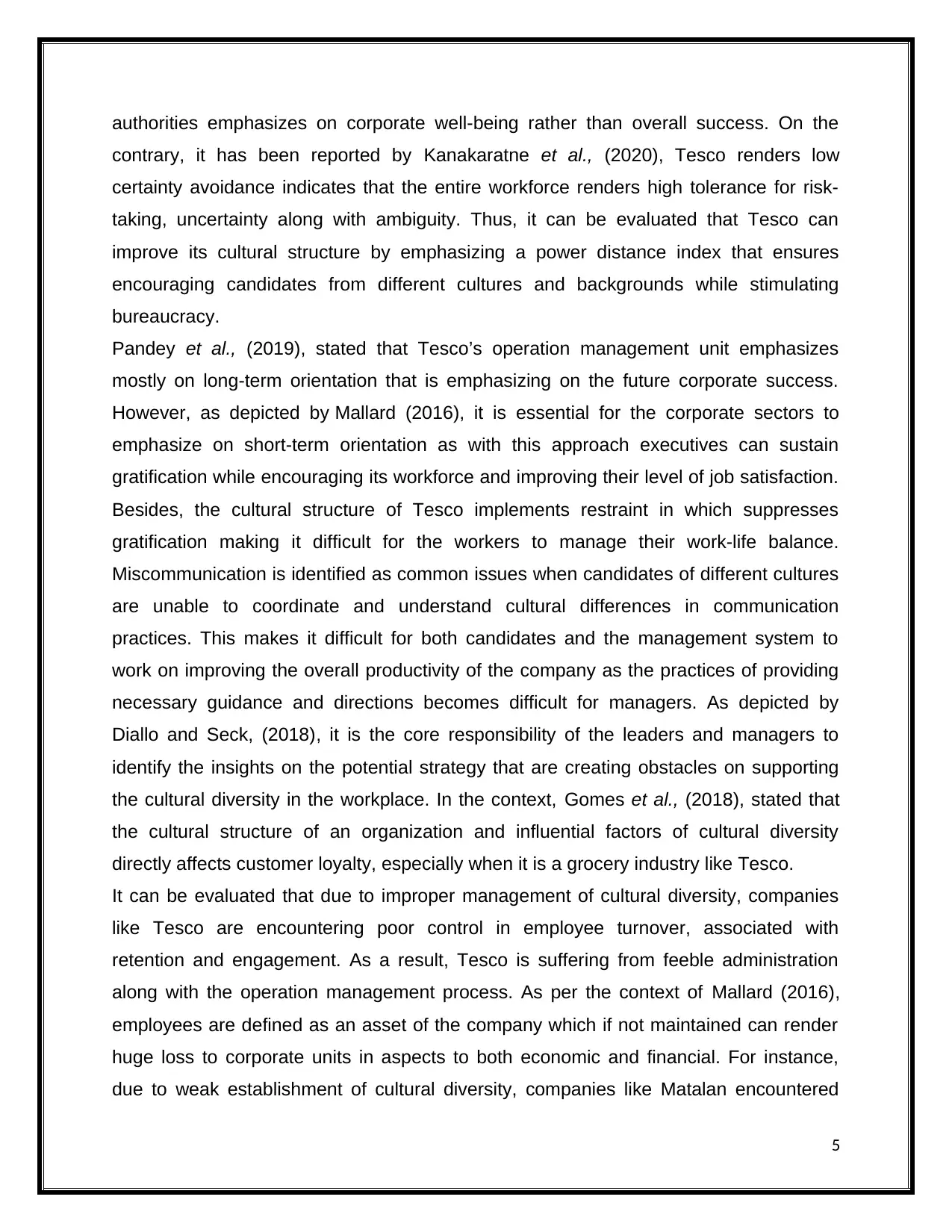
authorities emphasizes on corporate well-being rather than overall success. On the
contrary, it has been reported by Kanakaratne et al., (2020), Tesco renders low
certainty avoidance indicates that the entire workforce renders high tolerance for risk-
taking, uncertainty along with ambiguity. Thus, it can be evaluated that Tesco can
improve its cultural structure by emphasizing a power distance index that ensures
encouraging candidates from different cultures and backgrounds while stimulating
bureaucracy.
Pandey et al., (2019), stated that Tesco’s operation management unit emphasizes
mostly on long-term orientation that is emphasizing on the future corporate success.
However, as depicted by Mallard (2016), it is essential for the corporate sectors to
emphasize on short-term orientation as with this approach executives can sustain
gratification while encouraging its workforce and improving their level of job satisfaction.
Besides, the cultural structure of Tesco implements restraint in which suppresses
gratification making it difficult for the workers to manage their work-life balance.
Miscommunication is identified as common issues when candidates of different cultures
are unable to coordinate and understand cultural differences in communication
practices. This makes it difficult for both candidates and the management system to
work on improving the overall productivity of the company as the practices of providing
necessary guidance and directions becomes difficult for managers. As depicted by
Diallo and Seck, (2018), it is the core responsibility of the leaders and managers to
identify the insights on the potential strategy that are creating obstacles on supporting
the cultural diversity in the workplace. In the context, Gomes et al., (2018), stated that
the cultural structure of an organization and influential factors of cultural diversity
directly affects customer loyalty, especially when it is a grocery industry like Tesco.
It can be evaluated that due to improper management of cultural diversity, companies
like Tesco are encountering poor control in employee turnover, associated with
retention and engagement. As a result, Tesco is suffering from feeble administration
along with the operation management process. As per the context of Mallard (2016),
employees are defined as an asset of the company which if not maintained can render
huge loss to corporate units in aspects to both economic and financial. For instance,
due to weak establishment of cultural diversity, companies like Matalan encountered
5
contrary, it has been reported by Kanakaratne et al., (2020), Tesco renders low
certainty avoidance indicates that the entire workforce renders high tolerance for risk-
taking, uncertainty along with ambiguity. Thus, it can be evaluated that Tesco can
improve its cultural structure by emphasizing a power distance index that ensures
encouraging candidates from different cultures and backgrounds while stimulating
bureaucracy.
Pandey et al., (2019), stated that Tesco’s operation management unit emphasizes
mostly on long-term orientation that is emphasizing on the future corporate success.
However, as depicted by Mallard (2016), it is essential for the corporate sectors to
emphasize on short-term orientation as with this approach executives can sustain
gratification while encouraging its workforce and improving their level of job satisfaction.
Besides, the cultural structure of Tesco implements restraint in which suppresses
gratification making it difficult for the workers to manage their work-life balance.
Miscommunication is identified as common issues when candidates of different cultures
are unable to coordinate and understand cultural differences in communication
practices. This makes it difficult for both candidates and the management system to
work on improving the overall productivity of the company as the practices of providing
necessary guidance and directions becomes difficult for managers. As depicted by
Diallo and Seck, (2018), it is the core responsibility of the leaders and managers to
identify the insights on the potential strategy that are creating obstacles on supporting
the cultural diversity in the workplace. In the context, Gomes et al., (2018), stated that
the cultural structure of an organization and influential factors of cultural diversity
directly affects customer loyalty, especially when it is a grocery industry like Tesco.
It can be evaluated that due to improper management of cultural diversity, companies
like Tesco are encountering poor control in employee turnover, associated with
retention and engagement. As a result, Tesco is suffering from feeble administration
along with the operation management process. As per the context of Mallard (2016),
employees are defined as an asset of the company which if not maintained can render
huge loss to corporate units in aspects to both economic and financial. For instance,
due to weak establishment of cultural diversity, companies like Matalan encountered
5
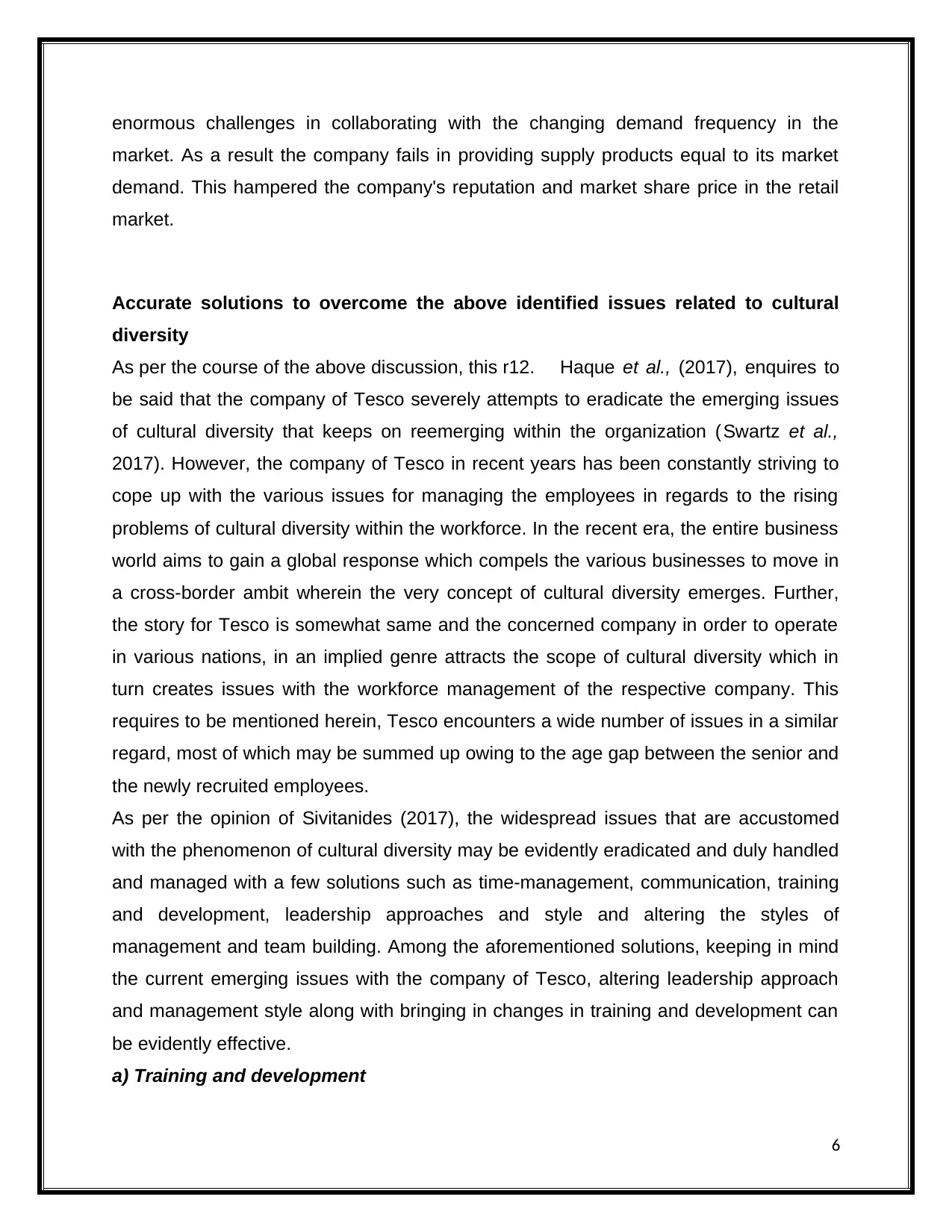
enormous challenges in collaborating with the changing demand frequency in the
market. As a result the company fails in providing supply products equal to its market
demand. This hampered the company's reputation and market share price in the retail
market.
Accurate solutions to overcome the above identified issues related to cultural
diversity
As per the course of the above discussion, this r12. Haque et al., (2017), enquires to
be said that the company of Tesco severely attempts to eradicate the emerging issues
of cultural diversity that keeps on reemerging within the organization (Swartz et al.,
2017). However, the company of Tesco in recent years has been constantly striving to
cope up with the various issues for managing the employees in regards to the rising
problems of cultural diversity within the workforce. In the recent era, the entire business
world aims to gain a global response which compels the various businesses to move in
a cross-border ambit wherein the very concept of cultural diversity emerges. Further,
the story for Tesco is somewhat same and the concerned company in order to operate
in various nations, in an implied genre attracts the scope of cultural diversity which in
turn creates issues with the workforce management of the respective company. This
requires to be mentioned herein, Tesco encounters a wide number of issues in a similar
regard, most of which may be summed up owing to the age gap between the senior and
the newly recruited employees.
As per the opinion of Sivitanides (2017), the widespread issues that are accustomed
with the phenomenon of cultural diversity may be evidently eradicated and duly handled
and managed with a few solutions such as time-management, communication, training
and development, leadership approaches and style and altering the styles of
management and team building. Among the aforementioned solutions, keeping in mind
the current emerging issues with the company of Tesco, altering leadership approach
and management style along with bringing in changes in training and development can
be evidently effective.
a) Training and development
6
market. As a result the company fails in providing supply products equal to its market
demand. This hampered the company's reputation and market share price in the retail
market.
Accurate solutions to overcome the above identified issues related to cultural
diversity
As per the course of the above discussion, this r12. Haque et al., (2017), enquires to
be said that the company of Tesco severely attempts to eradicate the emerging issues
of cultural diversity that keeps on reemerging within the organization (Swartz et al.,
2017). However, the company of Tesco in recent years has been constantly striving to
cope up with the various issues for managing the employees in regards to the rising
problems of cultural diversity within the workforce. In the recent era, the entire business
world aims to gain a global response which compels the various businesses to move in
a cross-border ambit wherein the very concept of cultural diversity emerges. Further,
the story for Tesco is somewhat same and the concerned company in order to operate
in various nations, in an implied genre attracts the scope of cultural diversity which in
turn creates issues with the workforce management of the respective company. This
requires to be mentioned herein, Tesco encounters a wide number of issues in a similar
regard, most of which may be summed up owing to the age gap between the senior and
the newly recruited employees.
As per the opinion of Sivitanides (2017), the widespread issues that are accustomed
with the phenomenon of cultural diversity may be evidently eradicated and duly handled
and managed with a few solutions such as time-management, communication, training
and development, leadership approaches and style and altering the styles of
management and team building. Among the aforementioned solutions, keeping in mind
the current emerging issues with the company of Tesco, altering leadership approach
and management style along with bringing in changes in training and development can
be evidently effective.
a) Training and development
6
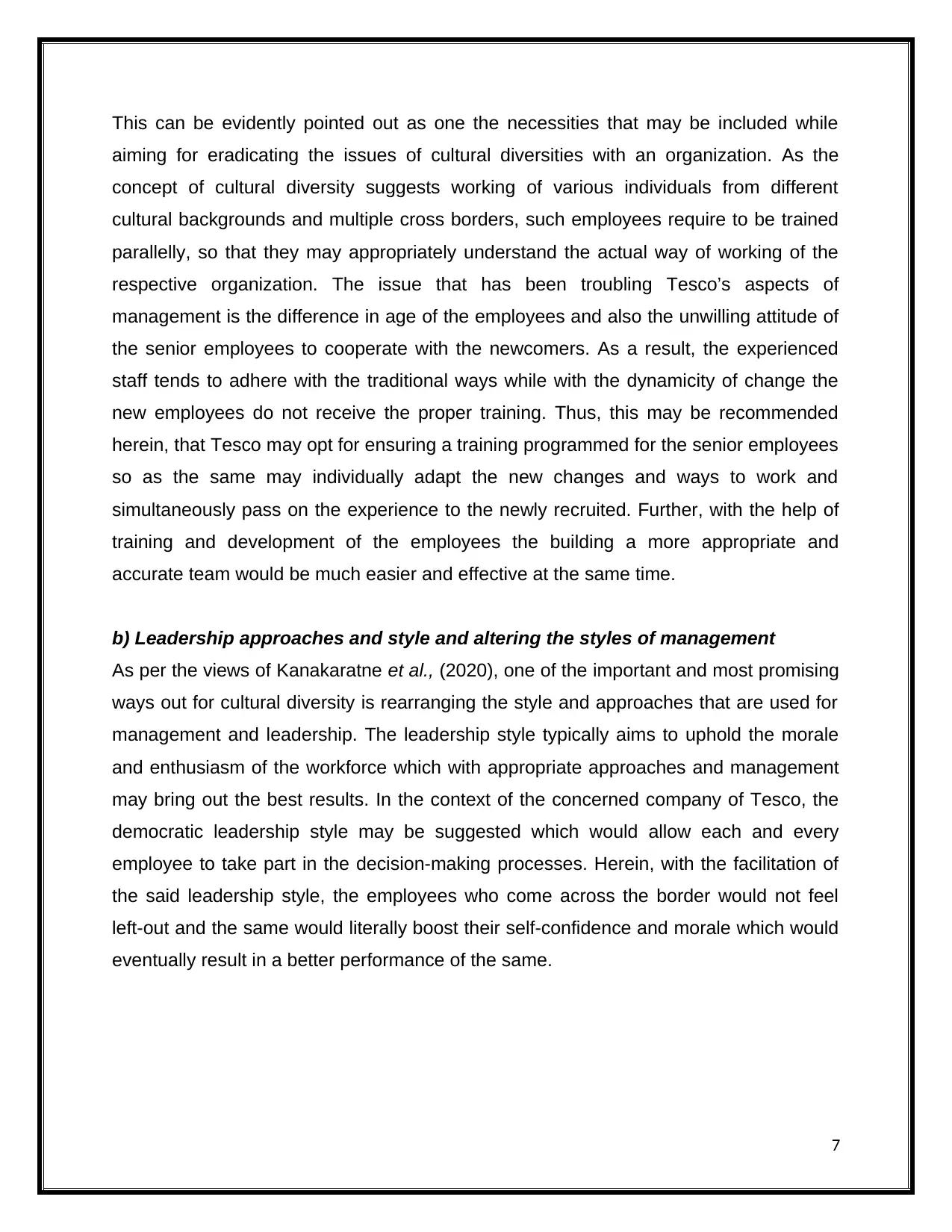
This can be evidently pointed out as one the necessities that may be included while
aiming for eradicating the issues of cultural diversities with an organization. As the
concept of cultural diversity suggests working of various individuals from different
cultural backgrounds and multiple cross borders, such employees require to be trained
parallelly, so that they may appropriately understand the actual way of working of the
respective organization. The issue that has been troubling Tesco’s aspects of
management is the difference in age of the employees and also the unwilling attitude of
the senior employees to cooperate with the newcomers. As a result, the experienced
staff tends to adhere with the traditional ways while with the dynamicity of change the
new employees do not receive the proper training. Thus, this may be recommended
herein, that Tesco may opt for ensuring a training programmed for the senior employees
so as the same may individually adapt the new changes and ways to work and
simultaneously pass on the experience to the newly recruited. Further, with the help of
training and development of the employees the building a more appropriate and
accurate team would be much easier and effective at the same time.
b) Leadership approaches and style and altering the styles of management
As per the views of Kanakaratne et al., (2020), one of the important and most promising
ways out for cultural diversity is rearranging the style and approaches that are used for
management and leadership. The leadership style typically aims to uphold the morale
and enthusiasm of the workforce which with appropriate approaches and management
may bring out the best results. In the context of the concerned company of Tesco, the
democratic leadership style may be suggested which would allow each and every
employee to take part in the decision-making processes. Herein, with the facilitation of
the said leadership style, the employees who come across the border would not feel
left-out and the same would literally boost their self-confidence and morale which would
eventually result in a better performance of the same.
7
aiming for eradicating the issues of cultural diversities with an organization. As the
concept of cultural diversity suggests working of various individuals from different
cultural backgrounds and multiple cross borders, such employees require to be trained
parallelly, so that they may appropriately understand the actual way of working of the
respective organization. The issue that has been troubling Tesco’s aspects of
management is the difference in age of the employees and also the unwilling attitude of
the senior employees to cooperate with the newcomers. As a result, the experienced
staff tends to adhere with the traditional ways while with the dynamicity of change the
new employees do not receive the proper training. Thus, this may be recommended
herein, that Tesco may opt for ensuring a training programmed for the senior employees
so as the same may individually adapt the new changes and ways to work and
simultaneously pass on the experience to the newly recruited. Further, with the help of
training and development of the employees the building a more appropriate and
accurate team would be much easier and effective at the same time.
b) Leadership approaches and style and altering the styles of management
As per the views of Kanakaratne et al., (2020), one of the important and most promising
ways out for cultural diversity is rearranging the style and approaches that are used for
management and leadership. The leadership style typically aims to uphold the morale
and enthusiasm of the workforce which with appropriate approaches and management
may bring out the best results. In the context of the concerned company of Tesco, the
democratic leadership style may be suggested which would allow each and every
employee to take part in the decision-making processes. Herein, with the facilitation of
the said leadership style, the employees who come across the border would not feel
left-out and the same would literally boost their self-confidence and morale which would
eventually result in a better performance of the same.
7
Paraphrase This Document
Need a fresh take? Get an instant paraphrase of this document with our AI Paraphraser
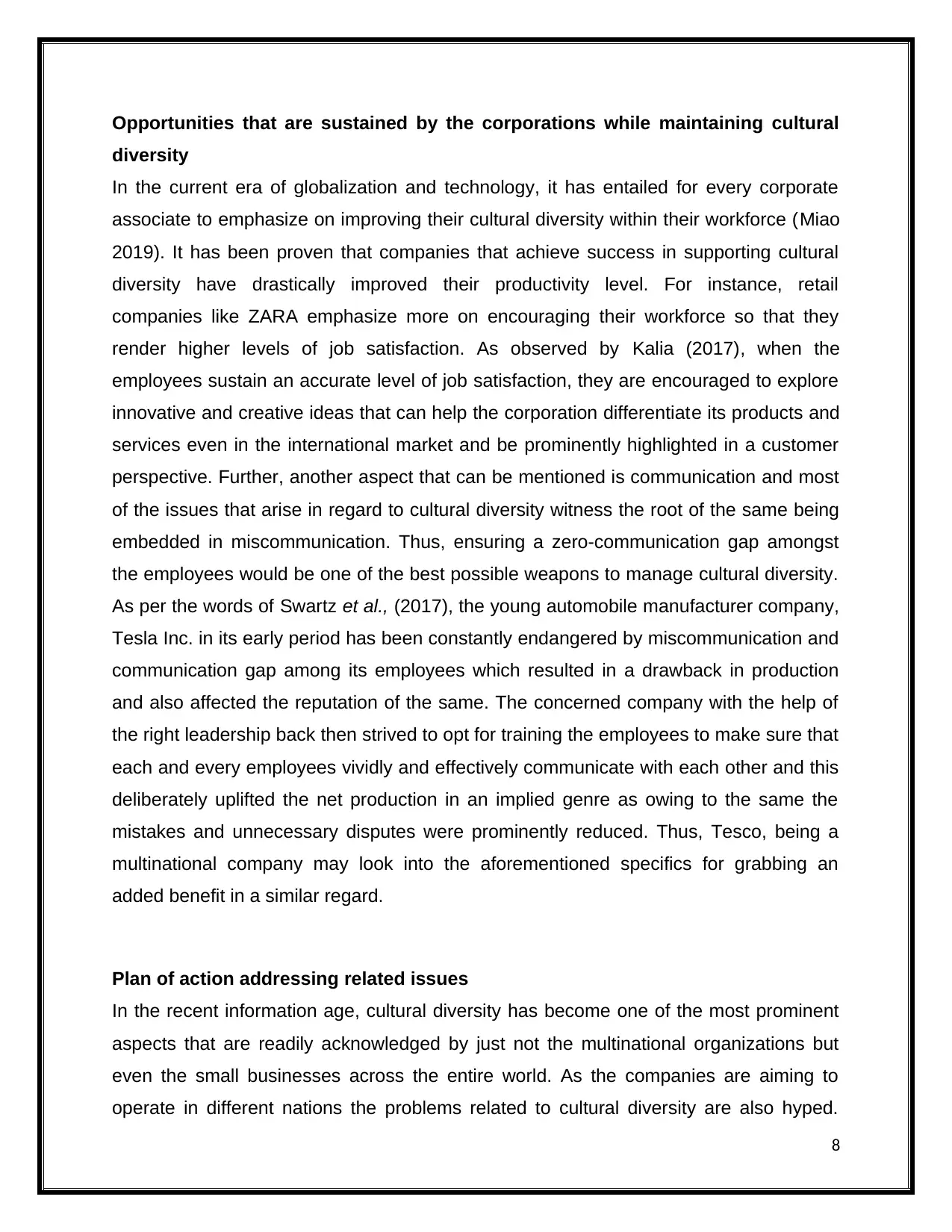
Opportunities that are sustained by the corporations while maintaining cultural
diversity
In the current era of globalization and technology, it has entailed for every corporate
associate to emphasize on improving their cultural diversity within their workforce (Miao
2019). It has been proven that companies that achieve success in supporting cultural
diversity have drastically improved their productivity level. For instance, retail
companies like ZARA emphasize more on encouraging their workforce so that they
render higher levels of job satisfaction. As observed by Kalia (2017), when the
employees sustain an accurate level of job satisfaction, they are encouraged to explore
innovative and creative ideas that can help the corporation differentiate its products and
services even in the international market and be prominently highlighted in a customer
perspective. Further, another aspect that can be mentioned is communication and most
of the issues that arise in regard to cultural diversity witness the root of the same being
embedded in miscommunication. Thus, ensuring a zero-communication gap amongst
the employees would be one of the best possible weapons to manage cultural diversity.
As per the words of Swartz et al., (2017), the young automobile manufacturer company,
Tesla Inc. in its early period has been constantly endangered by miscommunication and
communication gap among its employees which resulted in a drawback in production
and also affected the reputation of the same. The concerned company with the help of
the right leadership back then strived to opt for training the employees to make sure that
each and every employees vividly and effectively communicate with each other and this
deliberately uplifted the net production in an implied genre as owing to the same the
mistakes and unnecessary disputes were prominently reduced. Thus, Tesco, being a
multinational company may look into the aforementioned specifics for grabbing an
added benefit in a similar regard.
Plan of action addressing related issues
In the recent information age, cultural diversity has become one of the most prominent
aspects that are readily acknowledged by just not the multinational organizations but
even the small businesses across the entire world. As the companies are aiming to
operate in different nations the problems related to cultural diversity are also hyped.
8
diversity
In the current era of globalization and technology, it has entailed for every corporate
associate to emphasize on improving their cultural diversity within their workforce (Miao
2019). It has been proven that companies that achieve success in supporting cultural
diversity have drastically improved their productivity level. For instance, retail
companies like ZARA emphasize more on encouraging their workforce so that they
render higher levels of job satisfaction. As observed by Kalia (2017), when the
employees sustain an accurate level of job satisfaction, they are encouraged to explore
innovative and creative ideas that can help the corporation differentiate its products and
services even in the international market and be prominently highlighted in a customer
perspective. Further, another aspect that can be mentioned is communication and most
of the issues that arise in regard to cultural diversity witness the root of the same being
embedded in miscommunication. Thus, ensuring a zero-communication gap amongst
the employees would be one of the best possible weapons to manage cultural diversity.
As per the words of Swartz et al., (2017), the young automobile manufacturer company,
Tesla Inc. in its early period has been constantly endangered by miscommunication and
communication gap among its employees which resulted in a drawback in production
and also affected the reputation of the same. The concerned company with the help of
the right leadership back then strived to opt for training the employees to make sure that
each and every employees vividly and effectively communicate with each other and this
deliberately uplifted the net production in an implied genre as owing to the same the
mistakes and unnecessary disputes were prominently reduced. Thus, Tesco, being a
multinational company may look into the aforementioned specifics for grabbing an
added benefit in a similar regard.
Plan of action addressing related issues
In the recent information age, cultural diversity has become one of the most prominent
aspects that are readily acknowledged by just not the multinational organizations but
even the small businesses across the entire world. As the companies are aiming to
operate in different nations the problems related to cultural diversity are also hyped.
8
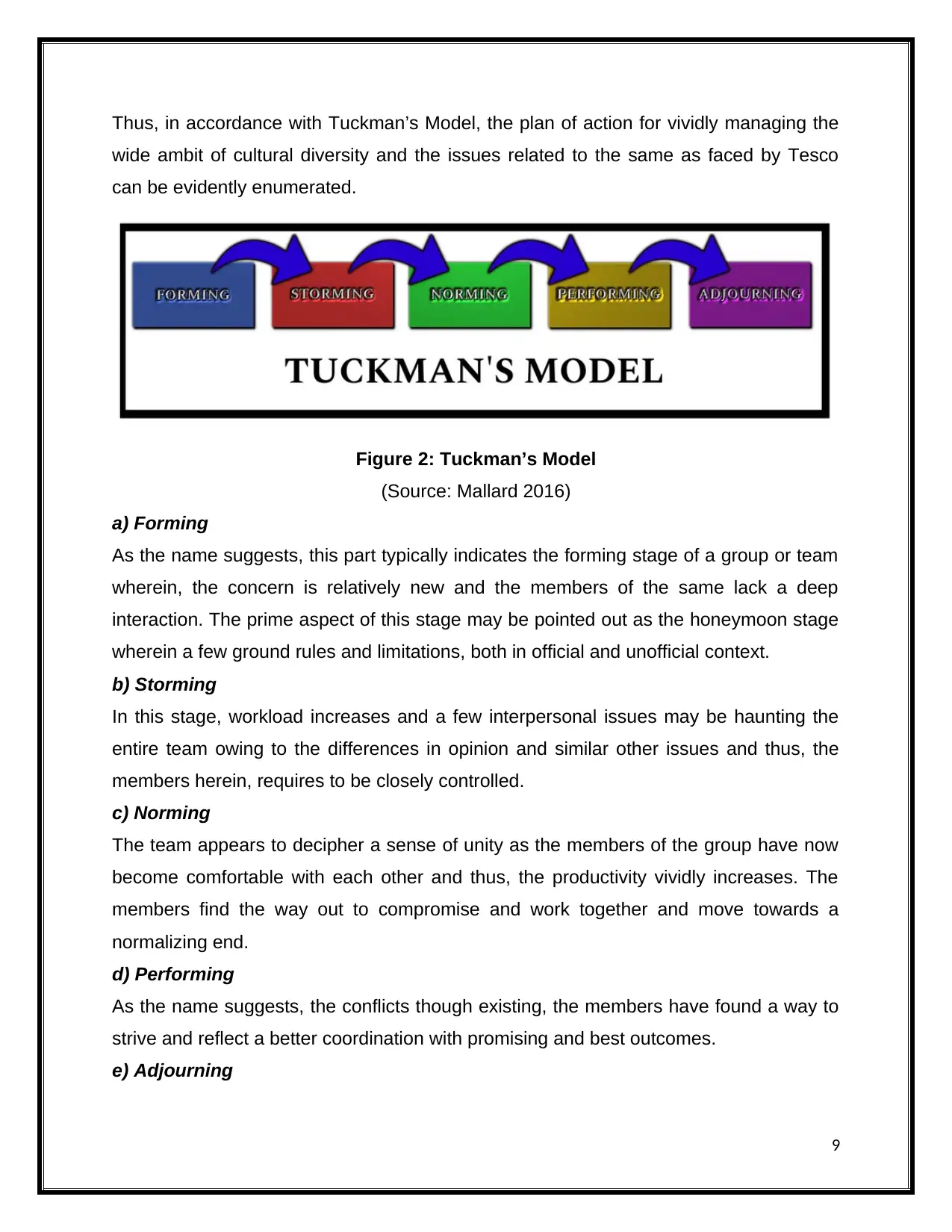
Thus, in accordance with Tuckman’s Model, the plan of action for vividly managing the
wide ambit of cultural diversity and the issues related to the same as faced by Tesco
can be evidently enumerated.
Figure 2: Tuckman’s Model
(Source: Mallard 2016)
a) Forming
As the name suggests, this part typically indicates the forming stage of a group or team
wherein, the concern is relatively new and the members of the same lack a deep
interaction. The prime aspect of this stage may be pointed out as the honeymoon stage
wherein a few ground rules and limitations, both in official and unofficial context.
b) Storming
In this stage, workload increases and a few interpersonal issues may be haunting the
entire team owing to the differences in opinion and similar other issues and thus, the
members herein, requires to be closely controlled.
c) Norming
The team appears to decipher a sense of unity as the members of the group have now
become comfortable with each other and thus, the productivity vividly increases. The
members find the way out to compromise and work together and move towards a
normalizing end.
d) Performing
As the name suggests, the conflicts though existing, the members have found a way to
strive and reflect a better coordination with promising and best outcomes.
e) Adjourning
9
wide ambit of cultural diversity and the issues related to the same as faced by Tesco
can be evidently enumerated.
Figure 2: Tuckman’s Model
(Source: Mallard 2016)
a) Forming
As the name suggests, this part typically indicates the forming stage of a group or team
wherein, the concern is relatively new and the members of the same lack a deep
interaction. The prime aspect of this stage may be pointed out as the honeymoon stage
wherein a few ground rules and limitations, both in official and unofficial context.
b) Storming
In this stage, workload increases and a few interpersonal issues may be haunting the
entire team owing to the differences in opinion and similar other issues and thus, the
members herein, requires to be closely controlled.
c) Norming
The team appears to decipher a sense of unity as the members of the group have now
become comfortable with each other and thus, the productivity vividly increases. The
members find the way out to compromise and work together and move towards a
normalizing end.
d) Performing
As the name suggests, the conflicts though existing, the members have found a way to
strive and reflect a better coordination with promising and best outcomes.
e) Adjourning
9
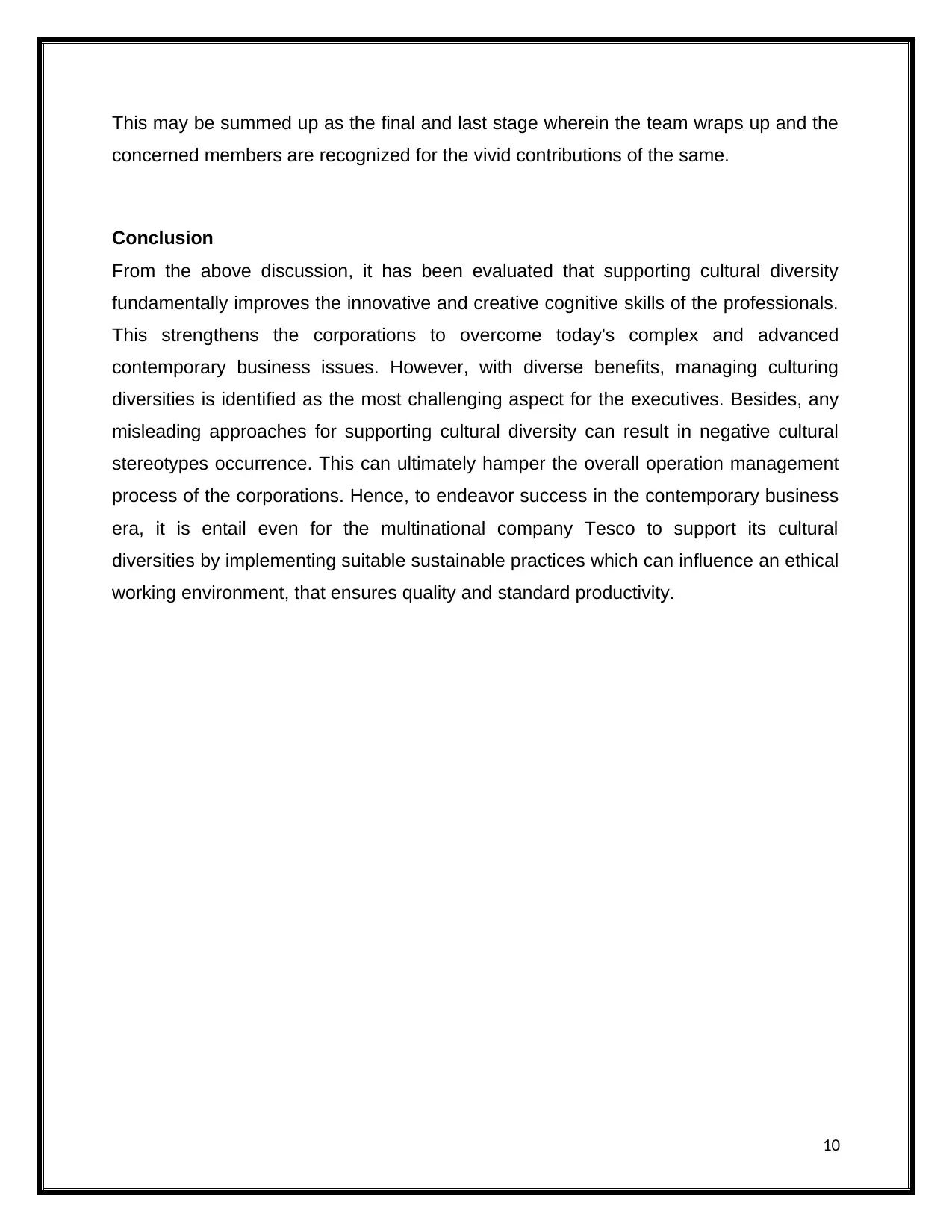
This may be summed up as the final and last stage wherein the team wraps up and the
concerned members are recognized for the vivid contributions of the same.
Conclusion
From the above discussion, it has been evaluated that supporting cultural diversity
fundamentally improves the innovative and creative cognitive skills of the professionals.
This strengthens the corporations to overcome today's complex and advanced
contemporary business issues. However, with diverse benefits, managing culturing
diversities is identified as the most challenging aspect for the executives. Besides, any
misleading approaches for supporting cultural diversity can result in negative cultural
stereotypes occurrence. This can ultimately hamper the overall operation management
process of the corporations. Hence, to endeavor success in the contemporary business
era, it is entail even for the multinational company Tesco to support its cultural
diversities by implementing suitable sustainable practices which can influence an ethical
working environment, that ensures quality and standard productivity.
10
concerned members are recognized for the vivid contributions of the same.
Conclusion
From the above discussion, it has been evaluated that supporting cultural diversity
fundamentally improves the innovative and creative cognitive skills of the professionals.
This strengthens the corporations to overcome today's complex and advanced
contemporary business issues. However, with diverse benefits, managing culturing
diversities is identified as the most challenging aspect for the executives. Besides, any
misleading approaches for supporting cultural diversity can result in negative cultural
stereotypes occurrence. This can ultimately hamper the overall operation management
process of the corporations. Hence, to endeavor success in the contemporary business
era, it is entail even for the multinational company Tesco to support its cultural
diversities by implementing suitable sustainable practices which can influence an ethical
working environment, that ensures quality and standard productivity.
10
Secure Best Marks with AI Grader
Need help grading? Try our AI Grader for instant feedback on your assignments.
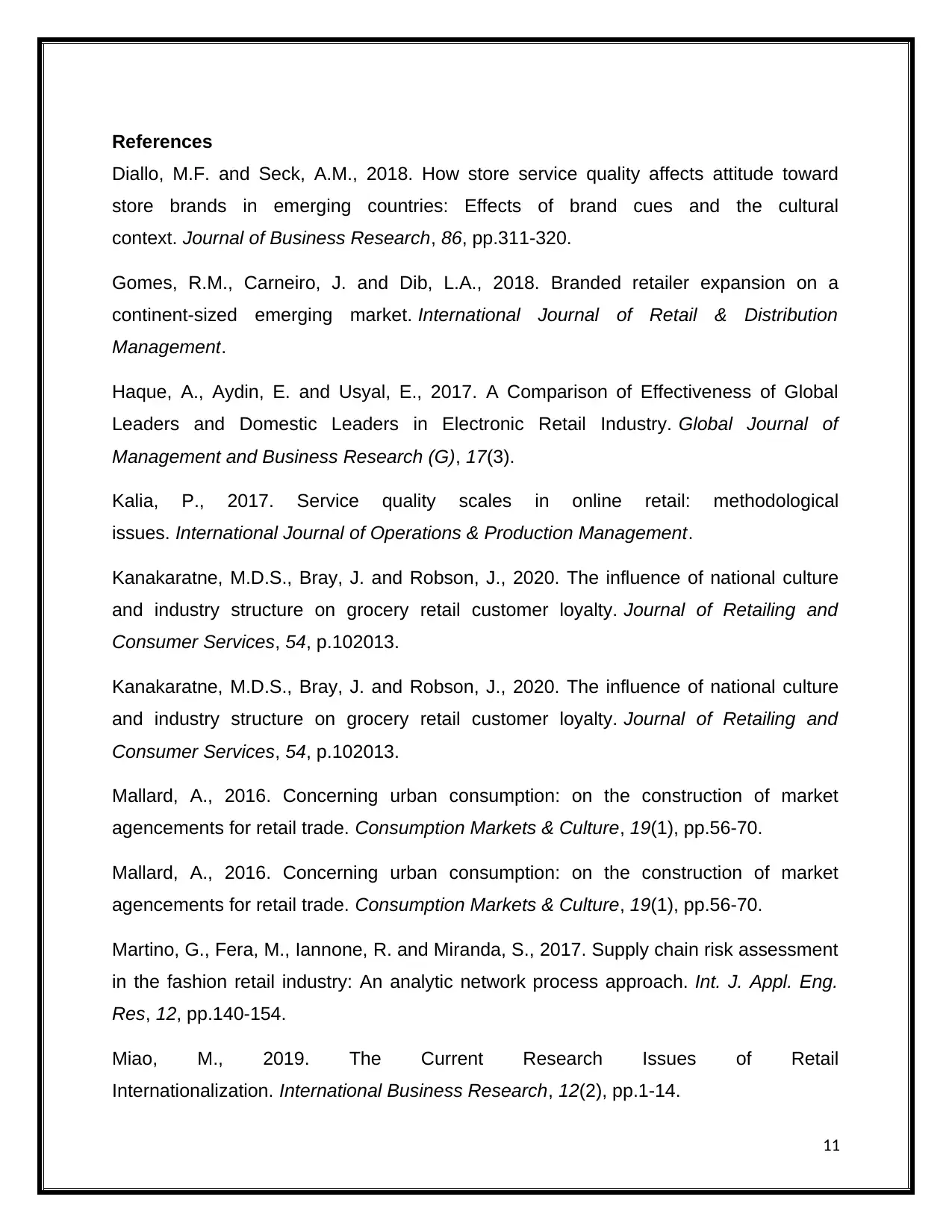
References
Diallo, M.F. and Seck, A.M., 2018. How store service quality affects attitude toward
store brands in emerging countries: Effects of brand cues and the cultural
context. Journal of Business Research, 86, pp.311-320.
Gomes, R.M., Carneiro, J. and Dib, L.A., 2018. Branded retailer expansion on a
continent-sized emerging market. International Journal of Retail & Distribution
Management.
Haque, A., Aydin, E. and Usyal, E., 2017. A Comparison of Effectiveness of Global
Leaders and Domestic Leaders in Electronic Retail Industry. Global Journal of
Management and Business Research (G), 17(3).
Kalia, P., 2017. Service quality scales in online retail: methodological
issues. International Journal of Operations & Production Management.
Kanakaratne, M.D.S., Bray, J. and Robson, J., 2020. The influence of national culture
and industry structure on grocery retail customer loyalty. Journal of Retailing and
Consumer Services, 54, p.102013.
Kanakaratne, M.D.S., Bray, J. and Robson, J., 2020. The influence of national culture
and industry structure on grocery retail customer loyalty. Journal of Retailing and
Consumer Services, 54, p.102013.
Mallard, A., 2016. Concerning urban consumption: on the construction of market
agencements for retail trade. Consumption Markets & Culture, 19(1), pp.56-70.
Mallard, A., 2016. Concerning urban consumption: on the construction of market
agencements for retail trade. Consumption Markets & Culture, 19(1), pp.56-70.
Martino, G., Fera, M., Iannone, R. and Miranda, S., 2017. Supply chain risk assessment
in the fashion retail industry: An analytic network process approach. Int. J. Appl. Eng.
Res, 12, pp.140-154.
Miao, M., 2019. The Current Research Issues of Retail
Internationalization. International Business Research, 12(2), pp.1-14.
11
Diallo, M.F. and Seck, A.M., 2018. How store service quality affects attitude toward
store brands in emerging countries: Effects of brand cues and the cultural
context. Journal of Business Research, 86, pp.311-320.
Gomes, R.M., Carneiro, J. and Dib, L.A., 2018. Branded retailer expansion on a
continent-sized emerging market. International Journal of Retail & Distribution
Management.
Haque, A., Aydin, E. and Usyal, E., 2017. A Comparison of Effectiveness of Global
Leaders and Domestic Leaders in Electronic Retail Industry. Global Journal of
Management and Business Research (G), 17(3).
Kalia, P., 2017. Service quality scales in online retail: methodological
issues. International Journal of Operations & Production Management.
Kanakaratne, M.D.S., Bray, J. and Robson, J., 2020. The influence of national culture
and industry structure on grocery retail customer loyalty. Journal of Retailing and
Consumer Services, 54, p.102013.
Kanakaratne, M.D.S., Bray, J. and Robson, J., 2020. The influence of national culture
and industry structure on grocery retail customer loyalty. Journal of Retailing and
Consumer Services, 54, p.102013.
Mallard, A., 2016. Concerning urban consumption: on the construction of market
agencements for retail trade. Consumption Markets & Culture, 19(1), pp.56-70.
Mallard, A., 2016. Concerning urban consumption: on the construction of market
agencements for retail trade. Consumption Markets & Culture, 19(1), pp.56-70.
Martino, G., Fera, M., Iannone, R. and Miranda, S., 2017. Supply chain risk assessment
in the fashion retail industry: An analytic network process approach. Int. J. Appl. Eng.
Res, 12, pp.140-154.
Miao, M., 2019. The Current Research Issues of Retail
Internationalization. International Business Research, 12(2), pp.1-14.
11
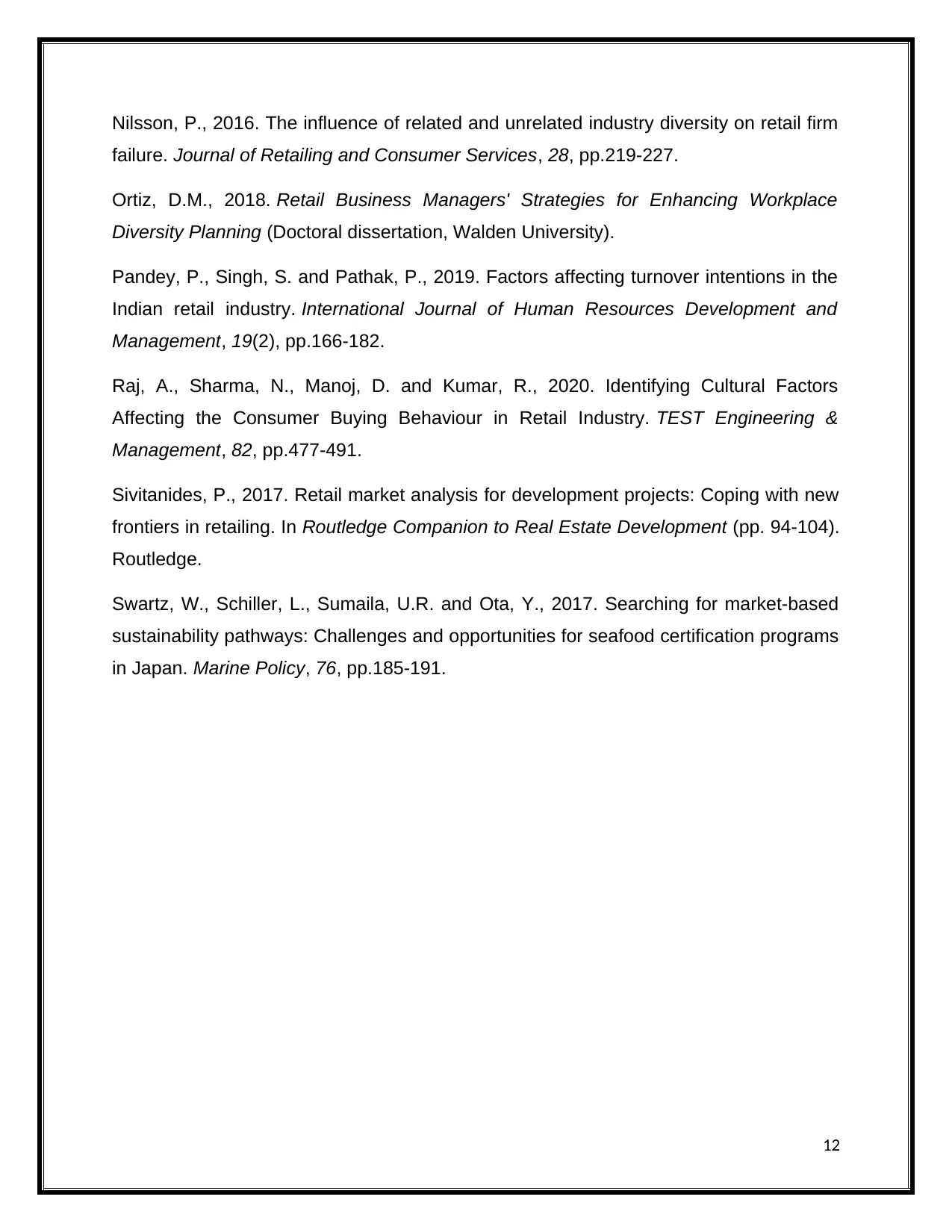
Nilsson, P., 2016. The influence of related and unrelated industry diversity on retail firm
failure. Journal of Retailing and Consumer Services, 28, pp.219-227.
Ortiz, D.M., 2018. Retail Business Managers' Strategies for Enhancing Workplace
Diversity Planning (Doctoral dissertation, Walden University).
Pandey, P., Singh, S. and Pathak, P., 2019. Factors affecting turnover intentions in the
Indian retail industry. International Journal of Human Resources Development and
Management, 19(2), pp.166-182.
Raj, A., Sharma, N., Manoj, D. and Kumar, R., 2020. Identifying Cultural Factors
Affecting the Consumer Buying Behaviour in Retail Industry. TEST Engineering &
Management, 82, pp.477-491.
Sivitanides, P., 2017. Retail market analysis for development projects: Coping with new
frontiers in retailing. In Routledge Companion to Real Estate Development (pp. 94-104).
Routledge.
Swartz, W., Schiller, L., Sumaila, U.R. and Ota, Y., 2017. Searching for market-based
sustainability pathways: Challenges and opportunities for seafood certification programs
in Japan. Marine Policy, 76, pp.185-191.
12
failure. Journal of Retailing and Consumer Services, 28, pp.219-227.
Ortiz, D.M., 2018. Retail Business Managers' Strategies for Enhancing Workplace
Diversity Planning (Doctoral dissertation, Walden University).
Pandey, P., Singh, S. and Pathak, P., 2019. Factors affecting turnover intentions in the
Indian retail industry. International Journal of Human Resources Development and
Management, 19(2), pp.166-182.
Raj, A., Sharma, N., Manoj, D. and Kumar, R., 2020. Identifying Cultural Factors
Affecting the Consumer Buying Behaviour in Retail Industry. TEST Engineering &
Management, 82, pp.477-491.
Sivitanides, P., 2017. Retail market analysis for development projects: Coping with new
frontiers in retailing. In Routledge Companion to Real Estate Development (pp. 94-104).
Routledge.
Swartz, W., Schiller, L., Sumaila, U.R. and Ota, Y., 2017. Searching for market-based
sustainability pathways: Challenges and opportunities for seafood certification programs
in Japan. Marine Policy, 76, pp.185-191.
12
1 out of 12
Related Documents
Your All-in-One AI-Powered Toolkit for Academic Success.
+13062052269
info@desklib.com
Available 24*7 on WhatsApp / Email
![[object Object]](/_next/static/media/star-bottom.7253800d.svg)
Unlock your academic potential
© 2024 | Zucol Services PVT LTD | All rights reserved.



